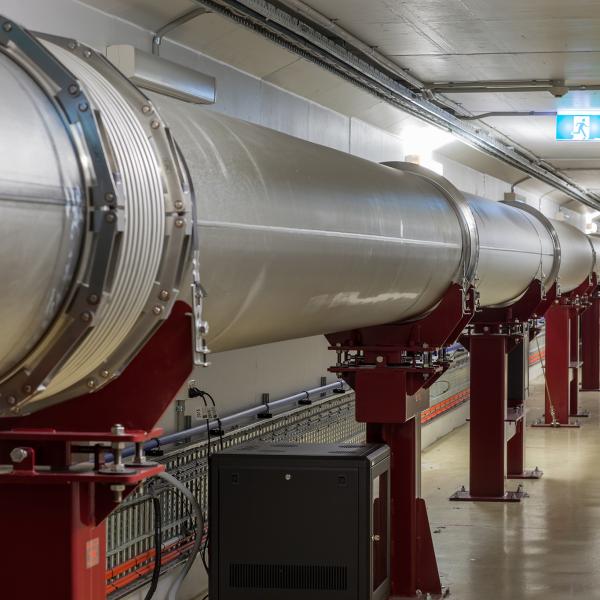

Published on the 10th January 2022 by ANSTO Staff
Key Points
-
New micro-computed tomography beamline reaches milestone with 'First Light'
-
The intensely powerful beam of synchrotron light left the main ring and entered the beamline for the first time late last year
-
The new beamline is expected to open a window to the minutely small nanoworld
Project BRIGHT, the construction of eight new beamlines at ANSTO’s Australian Synchrotron has reached a milestone by achieving ‘First Light’ for the new micro-computed tomography (MCT) beamline in late November.

Arrival of the optical components for the micro-computed tomography beamline
The new beamline is expected to open a window to the minutely small nanoworld, capable of capturing extensive sets of 2D images and then using them to reconstruct the intricate detail of the sample in 3D. This process is non-destructive and can be repeated at different times as the sample responds to, for example, changes in temperature or load.
‘First Light’ is the milestone event where the intensely powerful beam of synchrotron light leaves the main ring and enters the beamline for the first time.
“It represents a significant achievement,” said Senior Principal Scientist Dr Michael James.
“And it comes as a result of extraordinary efforts by a large number of ANSTO staff and contractors, who worked under multiple COVID restraints, and is testament to their skill and dedication.”
“Although we did not take the beam to the sample stage, which hasn’t been constructed yet, it gives confidence that we will be able to do so early in 2022,” explained James
“The COVID experience in Victoria made the challenges even more difficult than they would be in a normal engineering project.”
“Because the numbers of support people who could come from overseas vendors were limited, our staff had extra responsibilities.”
“Not to mention, shipping port delays and other hurdles.”
Accelerator staff in the main control room of the Australian Synchrotron worked with members of the MCT team to get to the point where the beamline first-optical enclosure, also known as a photon-delivery system, was receiving beam at full power within 30 hours of achieving ‘First Light’.
“We will use the remainder of the year to condition the optics and test the photon-delivery system,” he added,
The main accelerator ring was designed at the time to take synchrotron light into 10 beamlines but also to accommodate future beamlines.
“The front end of the beamline, which operates in conjunction with a bending magnet was already there from the original beamline build.”
We made a decision on the order to construct the new beamlines based on priorities set up in the project.
The new beamline, which will be used for high-resolution nano- and micro-scale imaging and CT at a scale of 100 to 5000 nanometres, can operate with four distinct photon-delivery modes including white-beam and monochromatic-beam.
The second and third beamline hutches provide the users with experimental stations capable of supporting a variety of X-ray imaging modalities and configurations. These include various novel forms of ‘phase-contrast’ imaging, which is key to improving the information content of the data for certain classes of samples.
Being able to select the X-ray energy of a monochromatic beam or tailor the spectrum encompassed within a white beam provides distinct advantages over conventional CT. The latter also opens the door to high-speed imaging, which is critical to certain research applications.
MCT Lead scientist Dr Andrew Stevenson and Project Manager Dr Prithi Tissa have a large technical team and external beamline advisory panel supporting the work.
“The techniques that will be available on this instrument complement CT that is undertaken on larger and/or denser objects using the Imaging and Medical beamline,” said Stevenson.
In addition to providing very quick high-throughput scanning, the beamline will have multiple detectors, remote access, and monitoring, and a robotic arm for sample positioning.
The instrument can, for example, be used in porosity and permeability studies of geological samples, and to analyse defects and study key features in materials produced by additive manufacturing—gaining a level of detail not available by other methods.
MCT is also used to reveal cracks, malformations, and defects in materials, such as bone, and study mechanics in living organisms in real-time.
The new beamline (located at sector 9) will sit between IMBL (sector 8) and Powder Diffraction (sector 10) in the experimental main hall. In due course, MCT will welcome nearest neighbours, the X-ray Fluorescence Nanoprobe, and the Advanced Diffraction and Scattering (ADS) beamlines. Both are Project BRIGHT beamlines to be constructed at a later stage.
MCT is expected to be available to users in the latter part of 2022.
To date, ANSTO has received $94.1 million of capital funding from some 30 contributors. This investment in Project BRIGHT will facilitate the design and installation of the eight additional beamlines, enabling the facility to meet the needs of Australian researchers and industry partners and continue enabling ground-breaking research well into the future.

